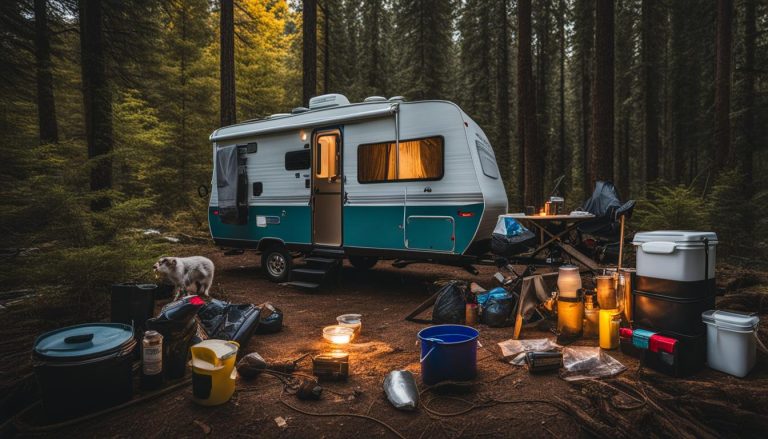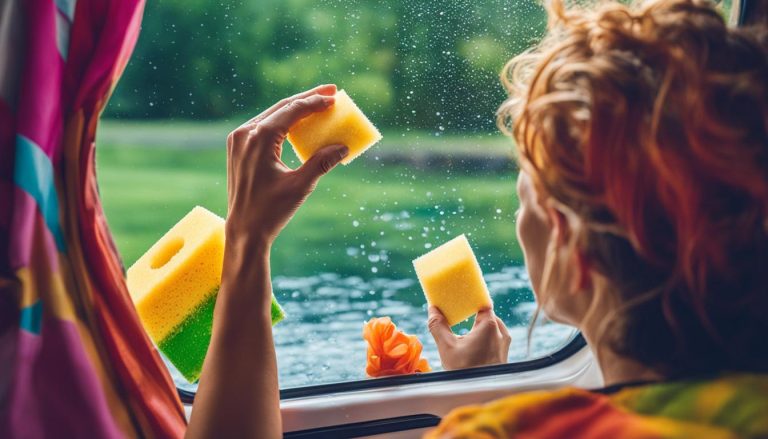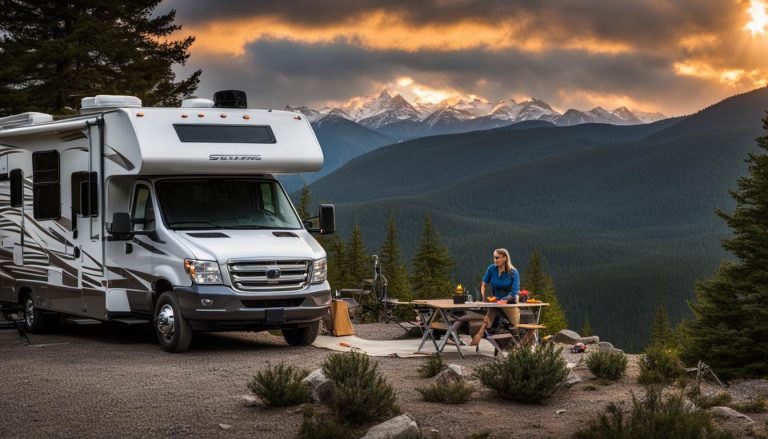Efficient RV Waste Tank Cleaning Guide
gorvlifestyle.com and its partners may earn a commission if you purchase a product through one of our links
Cleaning and maintaining your RV waste tanks is essential for a hassle-free and odor-free RV adventure. Properly understanding the different tanks in your RV, such as the black-water tank that holds toilet waste and the gray-water tank that holds used water from sinks and showers, is crucial. This guide will cover the best practices for cleaning and maintaining your RV waste tanks to prevent clogs, ensure efficient drainage, and eliminate unwanted odors.
Key Takeaways:
- Understanding the different tanks in your RV is important for effective waste tank cleaning.
- Proper cleaning involves hooking up a dump hose, emptying the tanks, and flushing with water.
- Choosing the right holding-tank treatment is crucial for keeping your waste tank clean and odor-free.
- Consider using an overnight holding tank treatment for thorough cleaning and odor elimination.
- Follow proper RV holding tank maintenance tips to prevent clogs and maintain efficient drainage.
Understanding RV Waste Tanks
RV waste tanks, including the black-water tank and gray-water tank, are essential components of your RV’s plumbing system. The black-water tank is responsible for holding toilet waste, while the gray-water tank holds used water from sinks and showers.
Properly understanding how these tanks function is crucial for effective cleaning and maintenance. When it comes to the black-water tank, it’s recommended to only empty it when it’s approximately two-thirds full. This ensures that there is enough water in the tank to help flush away solid waste.
To aid in the process of maintaining your RV waste tanks, it is beneficial to keep the gray-water tank valve closed and allow it to fill before draining. This practice helps to flush the sewer hose after emptying the black tank, promoting a cleaner and more efficient waste tank system.
By implementing these preventive measures and ensuring a comprehensive understanding of your RV waste tanks, you can achieve optimal efficiency and cleanliness in your RV waste tank maintenance.
RV Waste Tank Capacity:
| RV Waste Tank | Capacity |
|---|---|
| Black-Water Tank | Typically 40-50 gallons |
| Gray-Water Tank | Varies, depending on RV model |
Essential Steps to Clean RV Waste Tank
Cleaning your RV waste tank is an essential part of maintaining a hygienic and odor-free RV. Follow these steps to ensure a thorough cleaning:
- First, hook up a 3-inch dump hose with a right-angle fitting to the sewer port, and make sure all tank valves are closed.
- Remove the cap from the outlet pipe on your RV and attach the bayonet fitting of the sewer hose to the end of the pipe.
- Release the black tank valve to start emptying the tank. Remember to only empty the tank when it’s two-thirds full to ensure proper flush and prevent clogs.
- Use RV-specific toilet paper to avoid clogging the tank, and avoid using household cleaners that can react with RV-specific products.
- After emptying the tank, flush it with clean water using a clean-out wand or a tank flusher to remove any remaining waste and debris. Repeat this process multiple times for a thorough cleaning.
- Finally, add water and a holding-tank treatment to the tank to break down solids and reduce odors. Follow the manufacturer’s instructions for the recommended amount of treatment to use.
By following these steps, you can ensure that your RV waste tank is properly cleaned and maintained, providing you with a worry-free RVing experience.
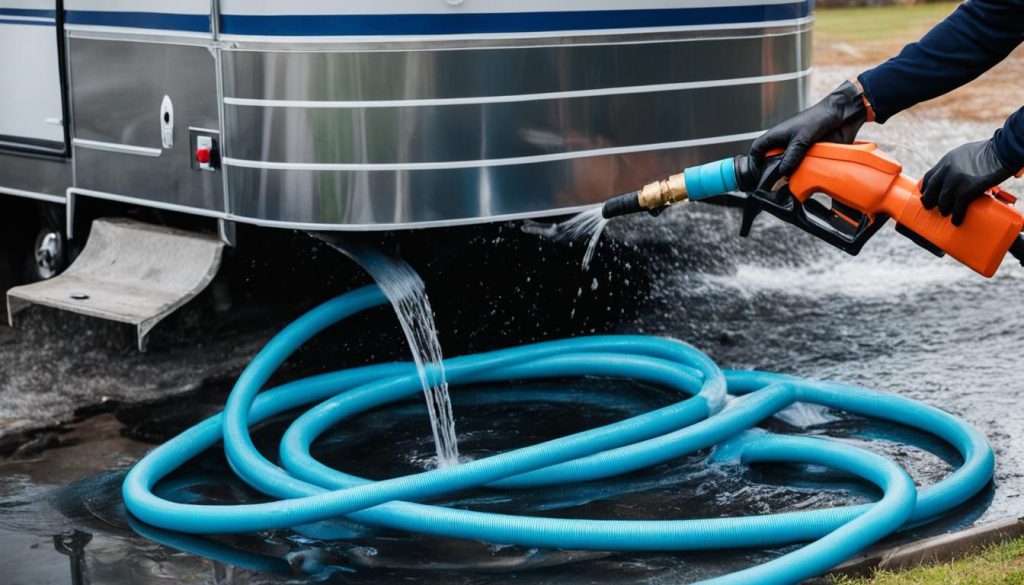
Tips for Cleaning RV Waste Tank
Here are a few additional tips to keep in mind while cleaning your RV waste tank:
- Regularly inspect and clean the tank sensors to ensure accurate monitoring of waste levels.
- Consider using enzyme-based holding-tank treatments to facilitate waste breakdown and control odors effectively.
- Practice responsible waste disposal by emptying your RV waste tank at designated RV dump stations or campground facilities.
- Establish a routine cleaning schedule to prevent buildup and maintain optimal tank performance.
By following these tips and maintaining a regular cleaning and maintenance routine, you can ensure that your RV waste tank remains in top condition, contributing to a cleaner and more enjoyable RVing experience.
| Tips for Cleaning RV Waste Tank | Steps to Clean RV Waste Tank | Proper Way to Clean RV Waste Tank |
|---|---|---|
| Regularly inspect and clean tank sensors | Hook up a 3-inch dump hose and close all tank valves | Use RV-specific toilet paper and avoid household cleaners |
| Consider using enzyme-based holding-tank treatments | Remove cap from the outlet pipe and attach sewer hose | Flush the tank with clean water using a wand or flusher |
| Practice responsible waste disposal | Release the black tank valve to empty the tank | Add water and holding-tank treatment to break down solids |
| Establish a routine cleaning schedule | Repeat the process multiple times for thorough cleaning | – |
Choosing the Right Holding-Tank Treatment
When it comes to keeping your RV waste tank clean and odor-free, selecting the right holding-tank treatment is essential. There are various options available, each with its own benefits and considerations. Let’s take a closer look at the three main types: bacterial treatments, enzyme treatments, and conventional chemicals.
Bacterial Treatments
Bacterial treatments are designed to break down waste and control odors in your RV waste tank. These treatments contain specialized bacteria that help decompose solid waste, reducing the chances of clogs and improving the overall cleanliness of the tank. However, it’s important to note that bacterial treatments may not be as effective at higher temperatures, so keep this in mind if you often travel to hot climates.
Enzyme Treatments
Enzyme treatments, on the other hand, use proteins to break down waste in your RV waste tank. While they don’t control odors as effectively as bacterial treatments, enzymes can still play a crucial role in preventing clogs and maintaining a clean tank. Enzyme treatments are generally safe to use and won’t harm the tank or its components.
Conventional Chemicals
Conventional chemicals have a long-standing reputation for reducing odors and breaking down waste in RV waste tanks. These products often contain ingredients like formaldehyde, which can be controversial due to their potential environmental impact. However, when used properly and in moderation, conventional chemicals can be effective in keeping your tank clean and free from odors.
When choosing the right holding-tank treatment, it’s important to consider your personal preferences and needs. Whether you prioritize odor control, waste breakdown, or environmental impact, there’s a treatment out there for you. Remember to always follow the manufacturer’s instructions for optimal results.
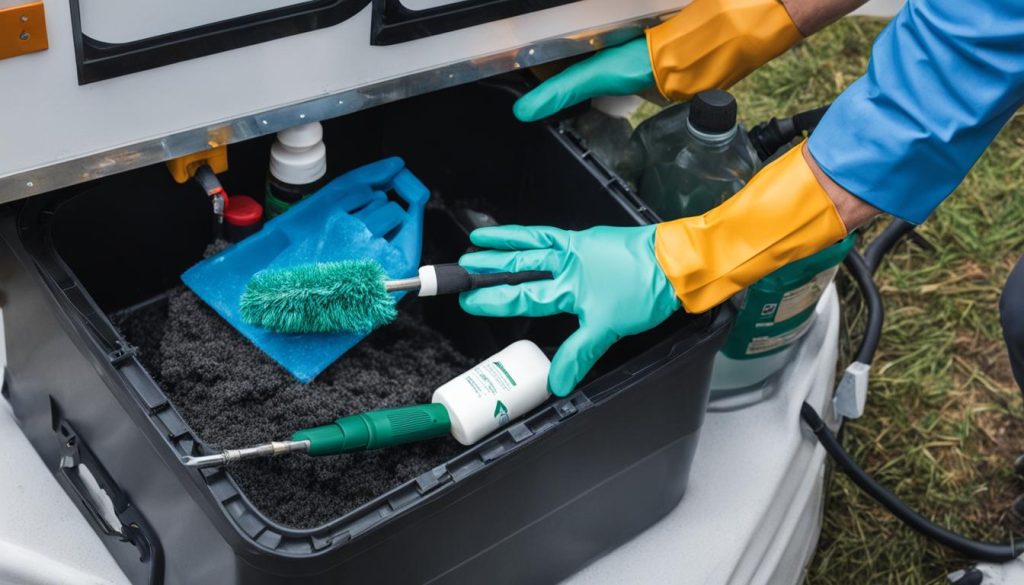
Comparison of Holding-Tank Treatments
| Treatment Type | Benefits | Considerations |
|---|---|---|
| Bacterial Treatments |
|
|
| Enzyme Treatments |
|
|
| Conventional Chemicals |
|
|
Use an Overnight RV Holding Tank Treatment
An efficient method for cleaning RV waste tanks is to use an overnight holding tank treatment. These enzymatic tank cleaners work by breaking down waste and eliminating odors overnight. Products like Super Seal Pirranha, Thetford Tank Blaster, and Walex CMDOBG Commando Black Holding Tank Cleaner are popular choices.
To use the treatment, follow these steps:
- Fill your holding tanks to more than 75% of their capacity.
- Empty the black tank first and flush it with water using a tank flusher or a flush valve.
- Mix the recommended dose of tank treatment with water.
- Pour the mixture down the toilet.
- Repeat the process in the morning to ensure thorough cleaning.
Cleaning your RV waste tank using an overnight holding tank treatment is an effective way to break down waste and eliminate odors. Remember to choose a reputable product and follow the instructions for optimal results.
Tips for Proper RV Holding Tank Maintenance
In addition to regular cleaning, proper RV holding tank maintenance is essential for preventing clogs and maintaining efficient drainage. Follow these tips to keep your RV waste tanks in optimal condition:
- Keep at least 5 gallons of water: Ensure your holding tanks have a sufficient amount of water, preferably 5 gallons or more. This prevents buildup and helps to keep the tanks from drying out.
- Flush only digested materials and RV-safe toilet paper: To avoid blockages, only flush down the RV toilet materials that can be easily digested by the holding tank’s bacteria. Use RV-safe toilet paper that dissolves quickly.
- Avoid harsh chemicals and bleach: Harsh chemicals and bleach can damage the tank and its seals over time. Stick to RV-specific tank treatments and cleaning products to maintain the tank’s integrity.
- Empty the black tank before the gray tank: Always empty the black tank first to ensure thorough flushing. This helps in preventing any undissolved solids from clogging the system.
Remember, maintaining a regular cleaning schedule and following these maintenance tips will help you avoid issues and keep your RV waste tanks functioning properly.
Note: Regular maintenance and proper cleaning practices will extend the lifespan of your RV waste tanks and ensure a stress-free RV experience.
Track Your RV Holding Tank Maintenance
Proper maintenance of your RV holding tank is crucial for the longevity and efficiency of your waste disposal system. To ensure you stay on top of cleaning and prevent costly repairs, it is essential to track your RV holding tank maintenance regularly.
An effective way to organize and manage your RV maintenance tasks is by utilizing an online tool like RV LIFE Maintenance. This tool allows you to keep all your maintenance documents in one convenient place, making it easy to access and update them when needed. Additionally, you can set up timely reminders for maintenance tasks, ensuring you never miss an important cleaning or servicing appointment.
By tracking your RV holding tank maintenance, you can follow best practices for cleaning and avoid potential issues such as clogs or system malfunctions. Regular inspections and cleanings will help maintain the integrity of your waste tank, ensuring it operates efficiently and avoids any unpleasant odors or leaks.
Take advantage of the convenience and peace of mind that comes with using RV LIFE Maintenance to track your RV holding tank maintenance. It will not only save you time and effort but also help you extend the lifespan of your waste disposal system, allowing you to fully enjoy your RV adventures without any unnecessary worries.
FAQ
How often should I clean my RV waste tank?
It is recommended to clean your RV waste tank at least every three months or whenever it becomes two-thirds full.
Can I use household cleaners to clean my RV waste tank?
No, it is best to avoid using household cleaners as they can react with RV-specific products. Stick to RV-specific toilet paper and cleaners.
What is the purpose of the gray-water tank in an RV?
The gray-water tank holds used water from sinks and showers. It is important to keep the gray-water tank valve closed and allow it to fill before draining to help flush the sewer hose after emptying the black tank.
How do I choose the right holding-tank treatment for my RV waste tank?
Consider bacterial treatments, enzyme treatments, and conventional chemicals. Each type has its advantages and limitations, so choose one that suits your preferences and follows the manufacturer’s instructions.
Are there any overnight holding tank treatments available for cleaning RV waste tanks?
Yes, there are enzymatic tank cleaners that work overnight to break down waste and eliminate odors. Products like Super Seal Pirranha, Thetford Tank Blaster, and Walex CMDOBG Commando Black Holding Tank Cleaner are popular choices.
What should I do to properly maintain my RV waste tanks?
Keep at least 5 gallons of water in your holding tanks to prevent buildup and drying out. Only flush digested materials and RV-safe toilet paper down the toilet. Avoid using harsh chemicals and bleach that can damage the tank and its seals.
How can I keep track of my RV holding tank maintenance?
You can use an online tool like RV LIFE Maintenance to organize and track all your RV maintenance and repair tasks. This tool helps you stay on top of cleaning and receive timely reminders when maintenance is due.

